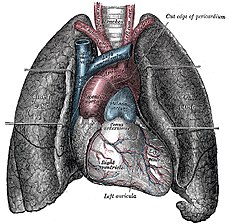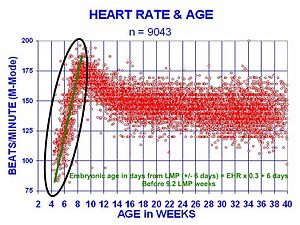Heart: Difference between revisions
updated heart animation links |
Qwertyu868 (talk | contribs) No edit summary |
||
| Line 165: | Line 165: | ||
[[zh-yue:心]] |
[[zh-yue:心]] |
||
[[zh:心臟]] |
[[zh:心臟]] |
||
The electrical system in your heart controls the speed of your heartbeat. The system includes a network of electrical pathways, similar to the electrical wiring in your home. The pathways carry electrical signals through your heart. The movement of the signals is what makes your heart beat. When working properly, your heart's electrical system automatically responds to your body's changing need for oxygen. It speeds up your heart rate as you climb stairs, for example, and slows it down when you sleep. When your heart rate speeds up, it means your heart pumps faster and your body gets more oxygen-rich blood. Your heart's electrical system is also called the cardiac conduction system. Specialized pacemaker cells in the sinoatrial node normally determine the overall rate of contractions, with an average resting pulse of 72 beats per minute. The central nervous system does not directly create the impulses to contract the heart, but only sends signals to speed up or slow down the heart rate through the autonomic nervous system using two opposing kinds of modulation: • (1) sympathetic nervous system (fight or flight response) • (2) parasympathetic nervous system (rest and repose) Since cardiac muscle is myogenic, the pacemaker serves only to modulate and coordinate contractions. The cardiac muscle cells would still fire in the absence of a functioning SA node pacemaker, albeit in a chaotic and ineffective manner. This condition is known as fibrillation. Note that the heart can still beat properly even if its connections to the central nervous system are completely severed. |
|||
Retrievedfrom "http://en.wikipedia.org/wiki/What_makes_the_heart_rate_speed_up" |
|||
Revision as of 17:21, 8 March 2007
Editing of this article by new or unregistered users is currently disabled. See the protection policy and protection log for more details. If you cannot edit this article and you wish to make a change, you can submit an edit request, discuss changes on the talk page, request unprotection, log in, or create an account. |

The heart is a pear shaped, muscular organ in vertebrates, responsible for pumping blood through the blood vessels by repeated, rhythmic contractions, or a similar structure in annelids, mollusks, and arthropods[1] The term cardiac (as in cardiology) means "related to the heart" and comes from the Greek καρδία, kardia, for "heart." The heart is composed of cardiac muscle, an involuntary muscle tissue which is found only within this organ.[2]
Early development

The human embryonic heart begins beating approximately 21 days after conception, or five weeks after the last normal menstrual period (LMP), which is the date normally used to date pregnancy. The human heart begins beating at a rate near the mother’s, about 75-80 beats per minute (bpm). The embryonic heart rate (EHR) then accelerates linearly for the first month of beating, peaking at 165-185 bpm during the early 7th week, (early 9th week after the LMP). This acceleration is approximately 3.3 bpm per day, or about 10 bpm every three days, an increase of 100 bpm in the first month. [1]
After peaking at about 9.2 weeks after the LMP, it decelerates to about 150 bpm (+/-25 bpm) during the 15th week after the LMP. After the 15th week the deceleration slows reaching an average rate of about 145 (+/-25 bpm) bpm at term. The regression formula which describes this acceleration before the embryo reaches 25 mm in crown-rump length or 9.2 LMP weeks is:
Age in days = EHR(0.3)+6
See: Embryonic Heart Rates Compared in Assisted and Non-Assisted Pregnancies
There is no difference in male and female heart rates before birth.[3]
Structure
In the human body, the heart is normally situated to the left of the middle of the thorax, underneath the breastbone (see diagrams). The heart is usually felt to be on the left side because the left heart (left ventricle) is stronger (it pumps to all body parts). The left lung is smaller than the right lung because the heart occupies more of the left hemithorax. The heart is enclosed by a sac known as the pericardium and is surrounded by the lungs. The pericardium is a double membrane structure containing a serous fluid to reduce friction during heart contractions. The mediastinum, a subdivision of the thoracic cavity, is the name of the heart cavity.
The apex is the blunt point situated in an inferior (pointing down and left) direction. A stethoscope can be placed directly over the apex so that the beats can be counted. This physical location is between the sixth and seventh rib, just to the left of the sternum [2]. In normal adults, the mass of the heart is 250-350 g (9-12 oz), or about three fourths the size of a clenched fist, but extremely diseased hearts can be up to 1000 g (2 lb) in mass due to hypertrophy. It consists of four chambers, the two upper atria (singular: atrium ) and the two lower ventricles. On the left is a picture of a fresh human heart which was removed from a 64-year-old British male.

The function of the right side of the heart (see right heart) is to collect deoxygenated blood, in the right atrium, from the body and pump it, via the right ventricle, into the lungs (pulmonary circulation) so that carbon dioxide can be dropped off and oxygen picked up (gas exchange). This happens through a passive process called diffusion. The left side (see left heart) collects oxygenated blood from the lungs into the left atrium. From the left atrium the blood moves to the left ventricle which pumps it out to the body. On both sides, the lower ventricles are thicker and stronger than the upper atria. The muscle wall surrounding the left ventricle is thicker than the wall surrounding the right ventricle due to the higher force needed to pump the blood through the systemic circulation.
First aid
See cardiac arrest for emergencies involving the heart
If a person is encountered in cardiac arrest (no heartbeat), cardiopulmonary resuscitation (CPR) should be started, and help called. If an automated external defibrillator is available, this device may automatically administer defibrillation if this is indicated.
Food use
The hearts of cattle, sheep, pigs, chickens and certain fowl are consumed as food in many countries. They are counted among offal, but being a muscle, the taste of heart is much more like regular meat than that of other offal. It resembles venison in structure and taste.
As a symbol
The heart was historically seen by some as the seat of the soul and the organ responsible for human thought. Even though we now know that the heart has nothing to do with thought or love, people still carry on using the term "heart" metaphorically when talking about love. When used in this metaphorical sense, the heart is often illustrated as an icon (♥).
The term "heart" can also refer to the core or centre of anything e.g. "The heart of the matter".
References
- ^ The American Heritage Stedman's Medical Dictionary. "KMLE Medical Dictionary Definition of heart".
{{cite web}}: External link in|author= - ^ The American Heritage Stedman's Medical Dictionary. "KMLE Medical Dictionary Definition of cardiac".
{{cite web}}: External link in|author= - ^ Terry J. DuBose Sex, Heart Rate and Age
See also
- Artificial heart
- Atrium
- Blood pressure
- Cardiology
- Cardiothoracic Surgery
- Cardiovascular pathology
- Circulatory system
- Echocardiography
- Electrical conduction system of the heart
- Haemodynamics
- Heart cancer
- Heart defects
- Heart rate
- Heart transplantation
- Heart valve
- Human anatomy
- Pulse
- Ventricle
- Aorta
- Ventricular hypertrophy
- Holiday heart syndrome
- Circle map — simplified mathematical model of the beating heart.
- MUGA scan
- Cardiac stress test
External links
- 3D Animated Heart with Anterior Cut - life-like 3D human heart animation with anterior cut.
- 3D Animated Heart Beat - life-like 3D human heart animation.
- American Heart Month - National month devoted to discussion of heart disease.
- eMedicine: Surgical anatomy of the heart
- Very Comprehensive Heart Site
- The InVision Guide to a Healthy Heart An interactive website
- Self Improvement Wednesday - ABC 702 Drive audio
- 3D Animated Heart - A great resource to view and interact with the anatomy of a 3 dimensional heart
- The circulatory system
- The position of the heart
- American Heart Association
♥
Template:Link FA Template:Link FA The electrical system in your heart controls the speed of your heartbeat. The system includes a network of electrical pathways, similar to the electrical wiring in your home. The pathways carry electrical signals through your heart. The movement of the signals is what makes your heart beat. When working properly, your heart's electrical system automatically responds to your body's changing need for oxygen. It speeds up your heart rate as you climb stairs, for example, and slows it down when you sleep. When your heart rate speeds up, it means your heart pumps faster and your body gets more oxygen-rich blood. Your heart's electrical system is also called the cardiac conduction system. Specialized pacemaker cells in the sinoatrial node normally determine the overall rate of contractions, with an average resting pulse of 72 beats per minute. The central nervous system does not directly create the impulses to contract the heart, but only sends signals to speed up or slow down the heart rate through the autonomic nervous system using two opposing kinds of modulation: • (1) sympathetic nervous system (fight or flight response) • (2) parasympathetic nervous system (rest and repose) Since cardiac muscle is myogenic, the pacemaker serves only to modulate and coordinate contractions. The cardiac muscle cells would still fire in the absence of a functioning SA node pacemaker, albeit in a chaotic and ineffective manner. This condition is known as fibrillation. Note that the heart can still beat properly even if its connections to the central nervous system are completely severed. Retrievedfrom "http://en.wikipedia.org/wiki/What_makes_the_heart_rate_speed_up"
